
Do you have a question about the ZyXEL Communications XGS4700 Series and is the answer not in the manual?
| Model | XGS4700 Series |
|---|---|
| Operating Temperature | 0°C to 50°C |
| Storage Temperature | -40°C to 70°C |
| Layer | Layer 3 |
| Product Type | Layer 3 Switch |
| Switching Capacity | 176 Gbps |
| Forwarding Rate | 131 Mpps |
| Jumbo Frame | 9K |
| Power Supply | AC 100-240V, 50/60Hz |
| Humidity | 10% to 90% non-condensing |
| Management | Web GUI, CLI, SNMP |
| Features | QoS, VLAN |
Manual for users configuring the switch via web configurator.
Lists other documentation like Web Configurator Online Help and Command Reference Guide.
Explains how warnings and notes are displayed in the guide.
Defines conventions for referring to the switch, product labels, keystrokes, and screen navigation.
Introduces the switch features, capabilities, and management methods.
Lists methods for managing the switch, including Web Configurator, CLI, and SNMP.
Provides recommendations for secure and effective switch management.
Instructions for installing the switch on a flat surface, including attaching rubber feet.
Details rack mounting requirements, precautions, and bracket attachment steps.
Guides on installing or removing AC and DC power modules.
Describes the front panel ports and their functions, including mini-GBIC slots.
Shows and lists components on the rear panel, including fan module, uplink modules, and power connectors.
Introduces the HTML-based management interface and browser requirements.
Steps to access the web configurator and log in using default credentials.
Details how to save configuration settings to runtime memory and nonvolatile memory.
Explains how to reload the factory default configuration file or reset the switch.
Lists configuration steps for an example network setup.
Details how to configure IP interfaces or routing domains for traffic routing.
Guides on setting up DHCP client pools for assigning network information.
Steps to enable RIP for exchanging routing information across different routing domains.
Tutorial on configuring DHCP snooping to control IP address assignment.
Tutorial on configuring the switch to forward DHCP client requests to a specific DHCP server.
Guide on shutting down ports due to loops or excessive ARP requests and configuring recovery.
Steps to set up a guest VLAN for clients failing 802.1x authentication, allowing limited network access.
How to view port statistics by clicking 'Status' on web configurator screens.
How to check firmware version, monitor temperature, fan speeds, and voltage.
Configuring general settings like system name and time, including NTP and Daylight Saving Time.
Configuring default gateway, DNS server, and IP domains for management.
Configuring port settings such as speed, duplex mode, and flow control.
Explains VLAN tagging using VLAN ID for frame identification and network processing.
Enables frames with unknown VLAN tags to pass through a port, useful for VLAN groups on end devices.
Configuring VLANs to decide frame forwarding based on VLAN tags or port membership.
Manually entering MAC addresses in the address table to control port access and reduce broadcasting.
Configuring rules to forward specific multicast frames to designated ports.
Configuring the switch to filter traffic based on source, destination MAC addresses, and/or VLAN group.
Explains (R)STP for detecting and breaking network loops, providing backup links.
Activating STP modes (RSTP, MRSTP, MSTP) via the Spanning Tree Configuration screen.
Explains Committed Information Rate (CIR) and Peak Information Rate (PIR) for guaranteed and maximum bandwidth.
Configuring ingress and egress rate limits on ports to manage bandwidth usage.
Limiting broadcast, multicast, and DLF packets per second on ports to prevent storms.
Copying traffic flow to a monitor port for detailed examination without interference.
Grouping physical ports into one logical, higher-capacity link for increased bandwidth.
The screen for configuring static link aggregation, including group ID and criteria.
Configuring LACP for dynamic link aggregation and port settings like timeout.
Validating client access to ports using IEEE 802.1x or MAC authentication via an external server.
Activating port authentication methods and configuring RADIUS server settings.
Activating IEEE 802.1x security and configuring settings for ports.
Setting up a guest VLAN for clients failing 802.1x authentication, allowing limited network access.
Allows packets with learned or configured static MAC addresses to pass through a port.
Enabling port security and disabling MAC address learning, or freezing MAC addresses.
Prioritizing traffic, fine-tuning network performance, and grouping traffic into data flows.
Defining classifiers to specify actions on traffic that matches rules.
Classifying traffic into flows and applying policy rules to ensure requested network treatment.
Configuring policy rules to define actions for classified traffic flows, potentially overriding default routing.
Using queuing algorithms to solve performance degradation during network congestion.
Configuring queuing methods like SPQ, WFQ, and WRR for outgoing traffic.
Distinguishing multiple customer VLANs by adding an outer VLAN tag to inner tagged frames.
Defining port roles as Normal, Access, or Tunnel for VLAN stacking.
Configuring VLAN stacking settings on the Switch, including port-based QinQ.
Internet Group Management Protocol for distributing data to multiple recipients, managing multicast sessions.
Snooping IGMP packets to learn group membership and forward multicast traffic efficiently.
Configuring IGMP snooping, including ports, timeouts, and filtering profiles.
Process of verifying user identity, defining user privileges, and recording user actions.
Enabling AAA functions and configuring server settings and priorities.
Configuring RADIUS server settings for authentication and accounting.
Configuring TACACS+ server settings for authentication and accounting.
Filtering unauthorized DHCP and ARP packets using a binding table with MAC, VLAN, IP, and port attributes.
Filtering unauthorized DHCP packets and building a binding table dynamically.
Filtering unauthorized ARP packets to prevent man-in-the-middle attacks.
Managing static bindings uniquely identified by MAC address and VLAN ID.
Shutting down a port if it detects packets looping back, preventing broadcast storms.
Enabling loop guard on the switch and configuring port settings, noting compatibility with STP.
Mapping VLAN IDs and priorities of received packets to service provider network usage.
Activating the VLAN mapping feature on the switch for ports.
Enabling and editing VLAN mapping rules, including port, VID, translated VID, and priority.
Tunneling layer-2 STP, CDP, and VTP packets between customer switches via the service provider network.
Enabling L2PT and configuring destination MAC address, port, and tunneling modes (Access, Tunnel).
Standard technology for monitoring switched networks by sampling traffic data and sending it to a collector.
Enabling the sFlow agent, configuring sample rate, poll interval, and collector address for each port.
Deploying PPPoE IA between server and clients to add subscriber information to discovery packets.
Configuring the switch to provide subscriber information for PPPoE client identification and authentication.
Specifying trusted/untrusted ports and adding extra information to PPPoE discovery packets.
Enabling PPPoE Intermediate Agent on a VLAN and appending Circuit ID/Remote ID to discovery packets.
Limiting control packet rates to the CPU to enhance efficiency and protect against DoS attacks.
Automatically undoing actions like port shutdown or packet discard after an error condition is resolved.
Limiting control packet rates (ARP, BPDU, IGMP) on ports to protect CPU efficiency.
Detecting exceeded rate limits for control packets and configuring actions like port shutdown or packet discard.
Using static routes to send data to devices not reachable through the default gateway.
Creating static routes by specifying destination IP, subnet mask, gateway IP, and metric.
Overriding default routing behavior based on administrator-defined policies and classifier criteria.
Creating policy routing profiles, which can include multiple policy routing rules.
Routing Information Protocol for exchanging routing information between routers, controlling sending/receiving of RIP packets.
Enabling RIP on the Switch and configuring administrative distance and direction.
Link-state protocol for distributing routing info within an autonomous system.
Activating OSPF and setting general parameters like Router ID and Distance.
Activating authentication for OSPF to ensure secure routing information exchange.
Configuring route redistribution and summary addresses for exchanging routing info with other protocols.
Configuring OSPF interfaces, including authentication, cost, and priority for router elections.
Internet Group Management Protocol for distributing data to multiple recipients, managing multicast sessions.
Enabling IGMP on the switch and selecting the IGMP version for query messages.
Distance Vector Multicast Routing Protocol for routing multicast data within an autonomous system.
Configuring DVMRP on the switch to act as a multicast router, requiring IGMP enablement.
Quality of Service prioritizing traffic flows using CoS and marking packets with DSCPs for per-hop treatment.
Limiting traffic transmission rates based on Committed Information Rate (CIR) and Peak Information Rate (PIR).
Enabling DiffServ to apply marking rules or IEEE 802.1p priority mapping on selected ports.
Configuring DSCP to IEEE 802.1p mapping for prioritizing traffic based on incoming DSCP values.
Dynamic Host Configuration Protocol for obtaining TCP/IP configuration from a server or relay agent.
Configuring DHCP relay for clients and servers not in the same broadcast domain.
Configuring DHCP settings on a per-VLAN basis, specifying server or relay function.
Virtual Router Redundancy Protocol for creating redundant backup gateways to ensure default gateway availability.
Configuring VRRP parameters, including IP interface setup and VRRP parameters.
Setting VRRP parameters like advertisement interval, priority, and preempt mode.
Demonstrates two VRRP configuration examples: One Subnet Network and Two Subnets.
Protocol for mapping IP addresses to MAC addresses, maintaining an association between them.
Supports ARP-Reply, Gratuitous-ARP, and ARP-Request learning modes for updating the ARP table.
Selecting the ARP learning mode (ARP-Reply, Gratuitous-ARP, ARP-Request) for ports.
Using Equal-Cost MultiPath (ECMP) to forward packets through multiple equal-cost paths for load balancing.
Configuring ECMP routing criteria, such as source IP or source/destination IP, for load balancing.
Managing firmware and configuration files, including upgrade, backup, restore, and factory defaults.
Resetting the switch configuration to factory defaults.
Downloading and uploading new firmware; ensuring correct model firmware is used.
Creating snapshots of switch configurations for later restoration.
Controlling access to the switch via console, Telnet, SSH, FTP, Web, and SNMP.
Simple Network Management Protocol for managing and monitoring TCP/IP devices using agents and managers.
Configuring administrator and non-administrator accounts for switch access.
Web protocol encrypting web pages using SSL/TLS for secure transactions and data integrity.
Deciding which services to use for accessing the switch and changing default service ports.
Specifying trusted computers for accessing the switch services remotely.
Checking system logs, pinging IP addresses, and performing port tests using the Diagnostic screen.
Syslog protocol for sending event notification messages to syslog servers for collection and analysis.
Configuring device system logging settings to send logs to an external syslog server.
Configuring a list of external syslog servers, including IP address and log level.
Managing switches through a cluster manager, requiring direct connection and same VLAN group.
Viewing cluster status, manager information, and member switch details.
Configuring cluster management settings, including cluster manager, candidate switches, and passwords.
Shows how frames are forwarded or filtered, displaying learned MAC addresses and their type (dynamic/static).
Searching specific MAC addresses and adding dynamic MAC addresses to static tables.
Shows how packets are forwarded or filtered, displaying IP addresses and their type (dynamic/static).
Displaying and arranging IP table data by IP address, VLAN group, or port number.
Protocol for mapping IP addresses to MAC addresses, maintaining an association between them.
Viewing IP-to-MAC mappings and removing specific dynamic ARP entries.
Contains route information to networks, updated with RIP and OSPF information.
Displaying routing table information, showing destination, gateway, interface, metric, and type.
Copying basic and advanced settings from a source port to destination ports.
Troubleshooting power issues, LED behavior, and hardware connections.
Resolving issues related to forgetting IP addresses, usernames, or passwords, and web configurator access.
Summarizes hardware features like dimensions, weight, interfaces, LEDs, and environmental specifications.
Details firmware specifications including default IP, user name, password, and supported features like VLAN, DHCP, and IGMP Snooping.
Lists Layer 2 and Layer 3 switching features, including Bridging, Switching fabric, QoS, VLAN, Port Aggregation, and Filtering.
Lists commonly used services, their protocols, port numbers, and descriptions.
Copyright notice and publication details for ZyXEL Communications Corporation.
ZyXEL's liability disclaimer regarding product application and use.
Includes FCC Interference Statement and CE Mark Warning.

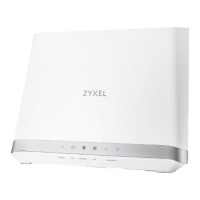
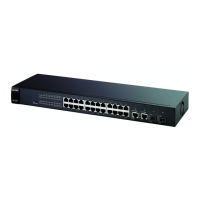

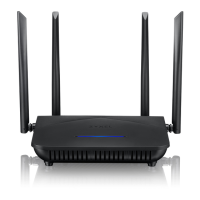
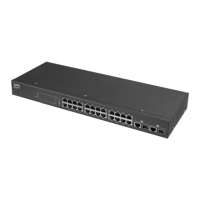

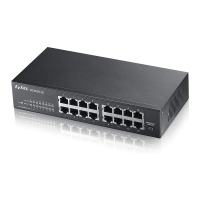


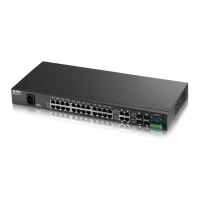
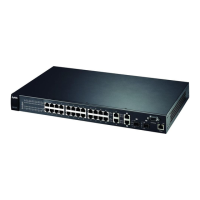
